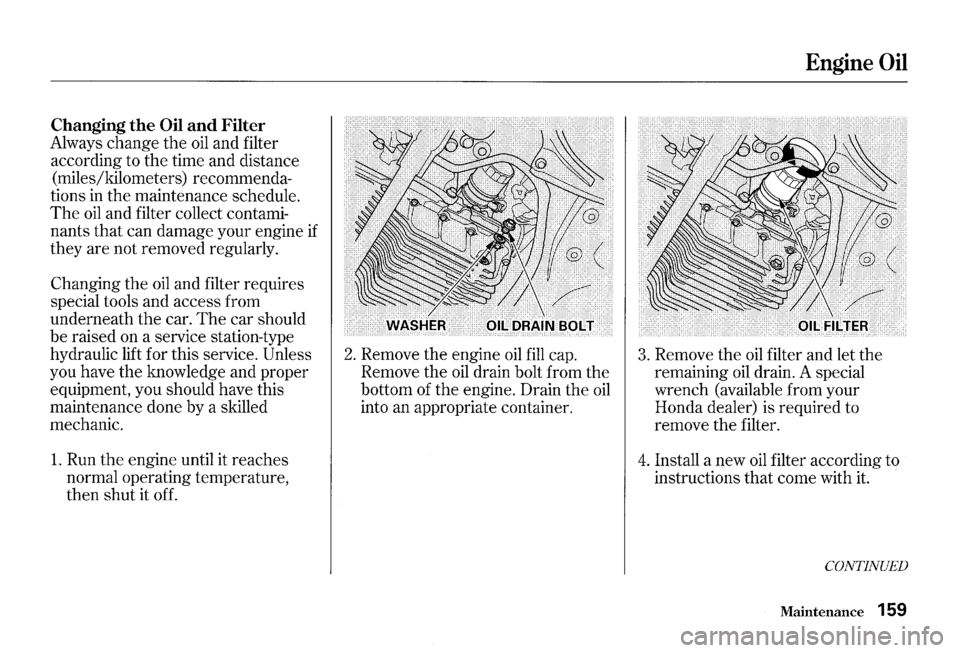Page 162 of 273

Changing the Oil and Filter
Always change the oil and filter
according to the time and distance
(miles/kilometers) recommenda
tions
in the maintenance schedule.
The oil and filter collect contami
nants that can damage your engine
if
they are not removed regularly.
Changing the
oil and filter requires
special tools and access from
underneath
the car. The car should
be raised on a service station-type
hydraulic lift for this service.
Unless
you have the knowledge and proper
equipment, you should have this
maintenance done by a skilled
mechanic.
1. Run the engine until it reaches
normal operating temperature,
then shut it off.
2. Remove the engine oil fill cap.
Remove the
oil drain bolt from the
bottom of
the engine. Drain the oil
into an appropriate container.
Engine Oil
3. Remove the oil filter and let the
remaining
oil drain. A special
wrench (available from your
Honda dealer) is required to
remove the filter.
4. Install a new oil filter according to
instructions that come with it.
CONTINUED
Maintenance 159
Page 163 of 273
Engine Oil
5. Put a new washer on the drain bolt,
then reinstall the drain bolt.
Tighten it to:
33 lbf.ft (45 N·m, 4.6 kgf·m)
6. Refill the engine with the recom
mended
oil.
Engine oil change capacity
(including filter):
5.1 US qt (4.8 Q, 4.2 Imp qt)
7. Install the engine oil fill cap. Start
the engine. The oil pressure
indicator light should go out within
five seconds. If it does not, turn off
the engine and reinspect your
work.
8. Let the engine run for several
minutes and check the drain bolt
and
oil filter for leaks.
160 Maintenance
9. Turn off the engine, let it sit for
several minutes, then check the
oil
level. If necessary, add oil to bring
the level to the upper mark on the
dipstick.
NOTICE
Improper disposal of engine oil can be
harmful
to the environment. If you
change your own oil, please dispose
of
the used oil properly. Put it in a sealed
container and take it
to a recycling
center. Do not discard it
in a trash bin
or dump it on the ground.
Page 166 of 273
Replacing Engine Coolant
The cooling system should be
completely drained and refilled with
new coolant according to
the time
and distance recommendations in
the maintenance schedule. Only use
Genuine Honda Antifreeze/Coolant.
Draining the coolant requires access
to
the underside of the vehicle.
Unless you have the tools and
knowledge, you should have this
maintenance done by a skilled
mechanic.
1. Turn the ignition ON (II). Turn
the heater temperature control
dial fully clockwise.
Turn the
ignition off.
2. Open the hood. Make sure the
engine and radiator are cool to the
touch.
3. Remove the radiator cap.
Cooling System
4. Loosen the drain plug on the
bottom of the radiator. The
coolant will drain through the
splash guard. Remove the drain
bolt and washer from the engine
block.
CONTINUED
Maintenance 163
Page 167 of 273
Cooling System
5. Remove the reserve tank from its
holder by pulling it straight
up.
Drain the coolant, then put the
tank back
in its holder.
164
Maintenance
6. When the coolant stops draining,
tighten the drain plug at
the
bottom of the radiator.
Apply non-hardening sealant to the
drain bolt threads, put a new
washer on the drain bolt, and
reinstall
the bolt in the engine
block. Tighten it securely.
Tightening torque:
61 lbf.ft (83 N·m I 8.5 kgf·m)
7. Mix the recommended antifreeze
with an equal amount of purified
or distilled water
in a clean
container.
The cooling system
capacity
is:
1.72 US gal (6.5 Q I 1.43 Imp gal)
8. Loosen the bleeder bolt on top of
the engine, and remove
the
bleeder cap near the engine oil fill
cap. Pour coolant into the radiator
up to the base of
the filler neck.
Tighten the bleeder bolt and
reinstall the bleeder cap when
coolant comes out in a steady
stream with no bubbles.
Page 171 of 273

6-speed Manual Transmission Fluid
Check the fluid level with the
transmission at normal operating
temperature and the car sitting on
level ground. Remove the
transmission filler bolt and carefully
feel inside the bolt hole with your
finger.
The fluid level should be up
to the edge of the bolt hole.
If it is
not, add Genuine Honda Manual
Transmission Fluid (MTF) until it
starts to run out of the hole. Reinstall
the filler bolt and tighten it securely.
168 Maintenance
If Honda MTF is not available, you
may use an
API service SG, SH or SJ
grade motor oil with a viscosity of
SAE lOW-30 or lOW-40 as a
temporary replacement. An
SG
grade is preferred, but an SH or SJ
grade may be used if SG is not
available. However, motor
oil does
not contain the proper additives and
continued use can cause stiffer
shifting. Replace as soon as
convenient.
The transmission should be drained
and refilled with new fluid according
to the time and distance recommen
dations
in the maintenance schedule.
Page 172 of 273
Check the fluid level with the
differential at normal operating
temperature and the vehicle sitting
onlevelground.Removethe
differential fluid filler bolt and
washer and carefully feel inside the
bolt hole with your finger.
The fluid
level should
be up to the edge of the
bolt hole.
If it is not, slowly add fluid
until it starts to run out of
the hole.
Use a SAE 90 viscosity hypoid gear
oil, API service classified GL5 or
GL6 only, in the differential.
Put a new washer on the filler bolt,
then reinstall the filler bolt. Tighten
it securely. Tightening torque:
33 lbf·ft (45 N·m, 4.6 kgf·m)
The differential should be drained
and refilled with new fluid according
to the time and distance
recommendations in the
maintenance schedule.
Differential Fluid
Maintenance 169